JCB (6-54, pp.244-262)
VerifiedAdded on 2019/12/04
|16
|5627
|37
Essay
AI Summary
The provided content is a collection of academic articles and books on global strategic management, international business, and organizational structure. The texts explore various aspects of globalization, including issues in global business and management research, global talent management, knowledge transfer, and organizational effectiveness. Additionally, the assignment includes company profiles of JCB, an excavator manufacturer, as well as marketing contacts and organizational structures. The references include a range of sources, from academic journals to textbooks, providing a comprehensive overview of the topics.
Contribute Materials
Your contribution can guide someone’s learning journey. Share your
documents today.
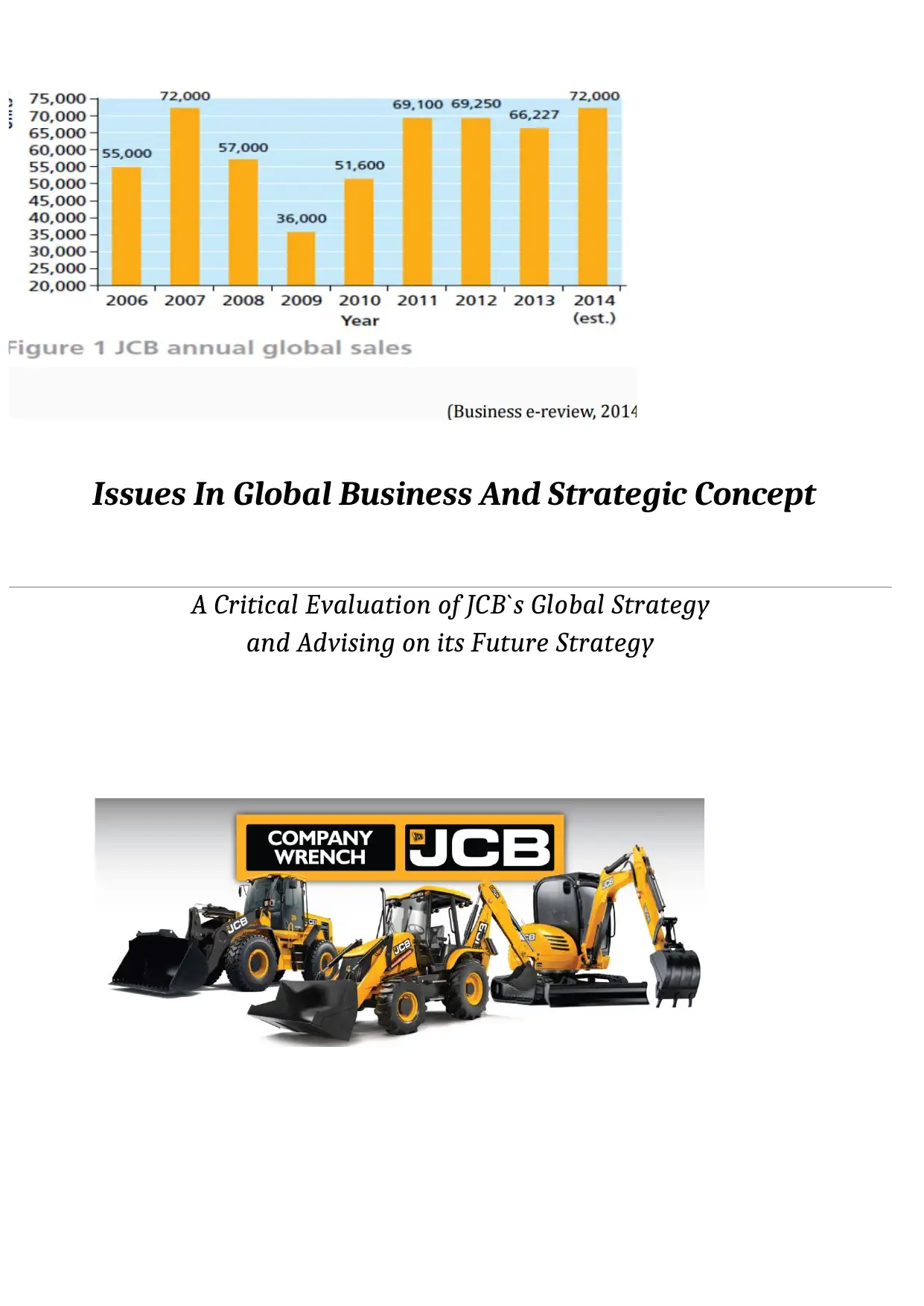
Issues In Global Business And Strategic Concept
A Critical Evaluation of JCB`s Global Strategy
and Advising on its Future Strategy
A Critical Evaluation of JCB`s Global Strategy
and Advising on its Future Strategy
Secure Best Marks with AI Grader
Need help grading? Try our AI Grader for instant feedback on your assignments.

TABLE OF CONTENTS
1.0.
1.0. INTRODUCTION............................................................................................................................................................. 3
2.0. JCB BACKGROUND................................................................................................................................................... 3
5.0. CONCLUSION .............................................................................................................................................................. 13
1.0.
1.0. INTRODUCTION............................................................................................................................................................. 3
2.0. JCB BACKGROUND................................................................................................................................................... 3
5.0. CONCLUSION .............................................................................................................................................................. 13
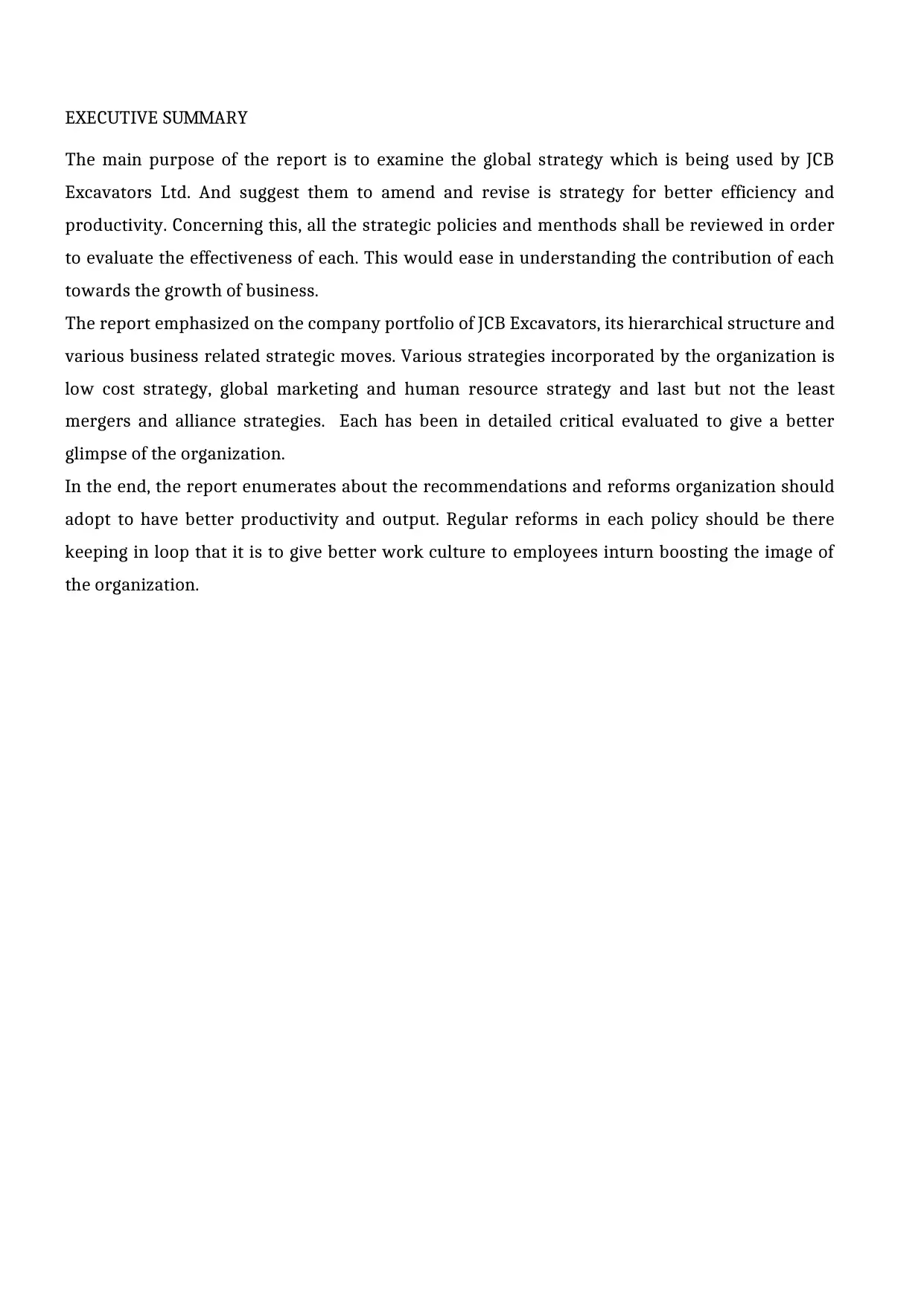
EXECUTIVE SUMMARY
The main purpose of the report is to examine the global strategy which is being used by JCB
Excavators Ltd. And suggest them to amend and revise is strategy for better efficiency and
productivity. Concerning this, all the strategic policies and menthods shall be reviewed in order
to evaluate the effectiveness of each. This would ease in understanding the contribution of each
towards the growth of business.
The report emphasized on the company portfolio of JCB Excavators, its hierarchical structure and
various business related strategic moves. Various strategies incorporated by the organization is
low cost strategy, global marketing and human resource strategy and last but not the least
mergers and alliance strategies. Each has been in detailed critical evaluated to give a better
glimpse of the organization.
In the end, the report enumerates about the recommendations and reforms organization should
adopt to have better productivity and output. Regular reforms in each policy should be there
keeping in loop that it is to give better work culture to employees inturn boosting the image of
the organization.
The main purpose of the report is to examine the global strategy which is being used by JCB
Excavators Ltd. And suggest them to amend and revise is strategy for better efficiency and
productivity. Concerning this, all the strategic policies and menthods shall be reviewed in order
to evaluate the effectiveness of each. This would ease in understanding the contribution of each
towards the growth of business.
The report emphasized on the company portfolio of JCB Excavators, its hierarchical structure and
various business related strategic moves. Various strategies incorporated by the organization is
low cost strategy, global marketing and human resource strategy and last but not the least
mergers and alliance strategies. Each has been in detailed critical evaluated to give a better
glimpse of the organization.
In the end, the report enumerates about the recommendations and reforms organization should
adopt to have better productivity and output. Regular reforms in each policy should be there
keeping in loop that it is to give better work culture to employees inturn boosting the image of
the organization.
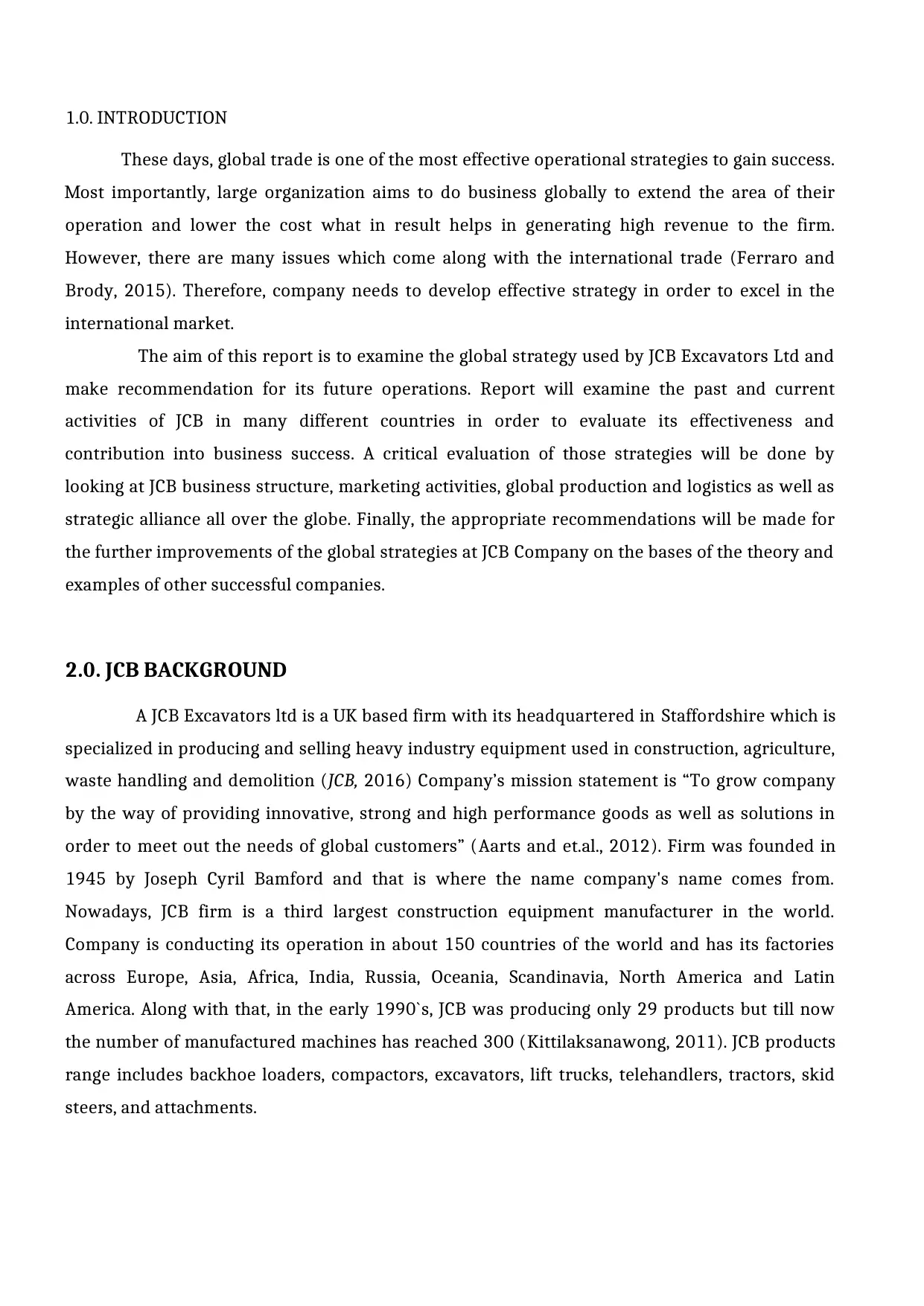
1.0. INTRODUCTION
These days, global trade is one of the most effective operational strategies to gain success.
Most importantly, large organization aims to do business globally to extend the area of their
operation and lower the cost what in result helps in generating high revenue to the firm.
However, there are many issues which come along with the international trade (Ferraro and
Brody, 2015). Therefore, company needs to develop effective strategy in order to excel in the
international market.
The aim of this report is to examine the global strategy used by JCB Excavators Ltd and
make recommendation for its future operations. Report will examine the past and current
activities of JCB in many different countries in order to evaluate its effectiveness and
contribution into business success. A critical evaluation of those strategies will be done by
looking at JCB business structure, marketing activities, global production and logistics as well as
strategic alliance all over the globe. Finally, the appropriate recommendations will be made for
the further improvements of the global strategies at JCB Company on the bases of the theory and
examples of other successful companies.
2.0. JCB BACKGROUND
A JCB Excavators ltd is a UK based firm with its headquartered in Staffordshire which is
specialized in producing and selling heavy industry equipment used in construction, agriculture,
waste handling and demolition (JCB, 2016) Company’s mission statement is “To grow company
by the way of providing innovative, strong and high performance goods as well as solutions in
order to meet out the needs of global customers” (Aarts and et.al., 2012). Firm was founded in
1945 by Joseph Cyril Bamford and that is where the name company's name comes from.
Nowadays, JCB firm is a third largest construction equipment manufacturer in the world.
Company is conducting its operation in about 150 countries of the world and has its factories
across Europe, Asia, Africa, India, Russia, Oceania, Scandinavia, North America and Latin
America. Along with that, in the early 1990`s, JCB was producing only 29 products but till now
the number of manufactured machines has reached 300 (Kittilaksanawong, 2011). JCB products
range includes backhoe loaders, compactors, excavators, lift trucks, telehandlers, tractors, skid
steers, and attachments.
These days, global trade is one of the most effective operational strategies to gain success.
Most importantly, large organization aims to do business globally to extend the area of their
operation and lower the cost what in result helps in generating high revenue to the firm.
However, there are many issues which come along with the international trade (Ferraro and
Brody, 2015). Therefore, company needs to develop effective strategy in order to excel in the
international market.
The aim of this report is to examine the global strategy used by JCB Excavators Ltd and
make recommendation for its future operations. Report will examine the past and current
activities of JCB in many different countries in order to evaluate its effectiveness and
contribution into business success. A critical evaluation of those strategies will be done by
looking at JCB business structure, marketing activities, global production and logistics as well as
strategic alliance all over the globe. Finally, the appropriate recommendations will be made for
the further improvements of the global strategies at JCB Company on the bases of the theory and
examples of other successful companies.
2.0. JCB BACKGROUND
A JCB Excavators ltd is a UK based firm with its headquartered in Staffordshire which is
specialized in producing and selling heavy industry equipment used in construction, agriculture,
waste handling and demolition (JCB, 2016) Company’s mission statement is “To grow company
by the way of providing innovative, strong and high performance goods as well as solutions in
order to meet out the needs of global customers” (Aarts and et.al., 2012). Firm was founded in
1945 by Joseph Cyril Bamford and that is where the name company's name comes from.
Nowadays, JCB firm is a third largest construction equipment manufacturer in the world.
Company is conducting its operation in about 150 countries of the world and has its factories
across Europe, Asia, Africa, India, Russia, Oceania, Scandinavia, North America and Latin
America. Along with that, in the early 1990`s, JCB was producing only 29 products but till now
the number of manufactured machines has reached 300 (Kittilaksanawong, 2011). JCB products
range includes backhoe loaders, compactors, excavators, lift trucks, telehandlers, tractors, skid
steers, and attachments.
Secure Best Marks with AI Grader
Need help grading? Try our AI Grader for instant feedback on your assignments.
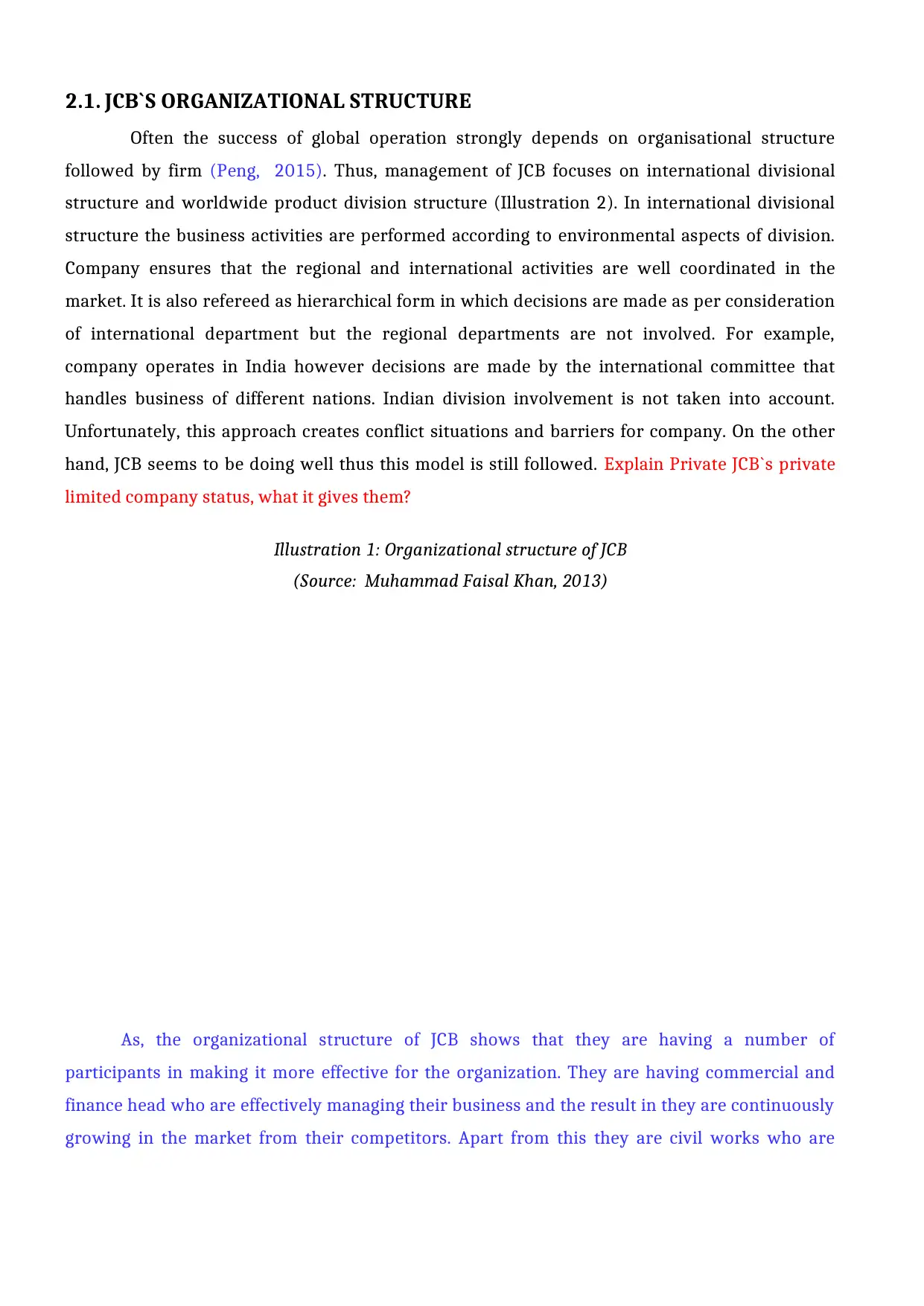
2.1. JCB`S ORGANIZATIONAL STRUCTURE
Often the success of global operation strongly depends on organisational structure
followed by firm (Peng, 2015). Thus, management of JCB focuses on international divisional
structure and worldwide product division structure (Illustration 2). In international divisional
structure the business activities are performed according to environmental aspects of division.
Company ensures that the regional and international activities are well coordinated in the
market. It is also refereed as hierarchical form in which decisions are made as per consideration
of international department but the regional departments are not involved. For example,
company operates in India however decisions are made by the international committee that
handles business of different nations. Indian division involvement is not taken into account.
Unfortunately, this approach creates conflict situations and barriers for company. On the other
hand, JCB seems to be doing well thus this model is still followed. Explain Private JCB`s private
limited company status, what it gives them?
As, the organizational structure of JCB shows that they are having a number of
participants in making it more effective for the organization. They are having commercial and
finance head who are effectively managing their business and the result in they are continuously
growing in the market from their competitors. Apart from this they are civil works who are
Illustration 1: Organizational structure of JCB
(Source: Muhammad Faisal Khan, 2013)
Often the success of global operation strongly depends on organisational structure
followed by firm (Peng, 2015). Thus, management of JCB focuses on international divisional
structure and worldwide product division structure (Illustration 2). In international divisional
structure the business activities are performed according to environmental aspects of division.
Company ensures that the regional and international activities are well coordinated in the
market. It is also refereed as hierarchical form in which decisions are made as per consideration
of international department but the regional departments are not involved. For example,
company operates in India however decisions are made by the international committee that
handles business of different nations. Indian division involvement is not taken into account.
Unfortunately, this approach creates conflict situations and barriers for company. On the other
hand, JCB seems to be doing well thus this model is still followed. Explain Private JCB`s private
limited company status, what it gives them?
As, the organizational structure of JCB shows that they are having a number of
participants in making it more effective for the organization. They are having commercial and
finance head who are effectively managing their business and the result in they are continuously
growing in the market from their competitors. Apart from this they are civil works who are
Illustration 1: Organizational structure of JCB
(Source: Muhammad Faisal Khan, 2013)
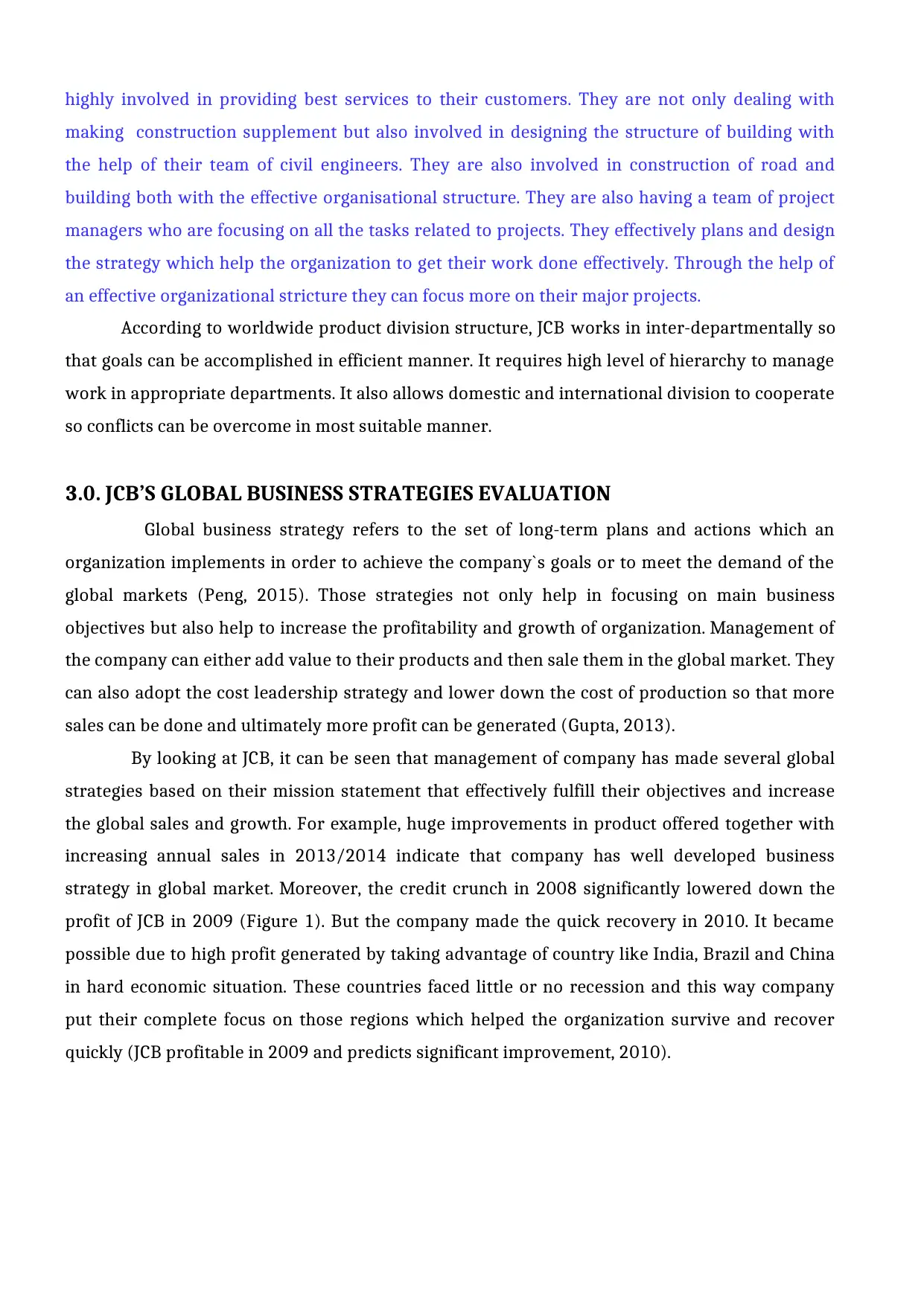
highly involved in providing best services to their customers. They are not only dealing with
making construction supplement but also involved in designing the structure of building with
the help of their team of civil engineers. They are also involved in construction of road and
building both with the effective organisational structure. They are also having a team of project
managers who are focusing on all the tasks related to projects. They effectively plans and design
the strategy which help the organization to get their work done effectively. Through the help of
an effective organizational stricture they can focus more on their major projects.
According to worldwide product division structure, JCB works in inter-departmentally so
that goals can be accomplished in efficient manner. It requires high level of hierarchy to manage
work in appropriate departments. It also allows domestic and international division to cooperate
so conflicts can be overcome in most suitable manner.
3.0. JCB’S GLOBAL BUSINESS STRATEGIES EVALUATION
Global business strategy refers to the set of long-term plans and actions which an
organization implements in order to achieve the company`s goals or to meet the demand of the
global markets (Peng, 2015). Those strategies not only help in focusing on main business
objectives but also help to increase the profitability and growth of organization. Management of
the company can either add value to their products and then sale them in the global market. They
can also adopt the cost leadership strategy and lower down the cost of production so that more
sales can be done and ultimately more profit can be generated (Gupta, 2013).
By looking at JCB, it can be seen that management of company has made several global
strategies based on their mission statement that effectively fulfill their objectives and increase
the global sales and growth. For example, huge improvements in product offered together with
increasing annual sales in 2013/2014 indicate that company has well developed business
strategy in global market. Moreover, the credit crunch in 2008 significantly lowered down the
profit of JCB in 2009 (Figure 1). But the company made the quick recovery in 2010. It became
possible due to high profit generated by taking advantage of country like India, Brazil and China
in hard economic situation. These countries faced little or no recession and this way company
put their complete focus on those regions which helped the organization survive and recover
quickly (JCB profitable in 2009 and predicts significant improvement, 2010).
making construction supplement but also involved in designing the structure of building with
the help of their team of civil engineers. They are also involved in construction of road and
building both with the effective organisational structure. They are also having a team of project
managers who are focusing on all the tasks related to projects. They effectively plans and design
the strategy which help the organization to get their work done effectively. Through the help of
an effective organizational stricture they can focus more on their major projects.
According to worldwide product division structure, JCB works in inter-departmentally so
that goals can be accomplished in efficient manner. It requires high level of hierarchy to manage
work in appropriate departments. It also allows domestic and international division to cooperate
so conflicts can be overcome in most suitable manner.
3.0. JCB’S GLOBAL BUSINESS STRATEGIES EVALUATION
Global business strategy refers to the set of long-term plans and actions which an
organization implements in order to achieve the company`s goals or to meet the demand of the
global markets (Peng, 2015). Those strategies not only help in focusing on main business
objectives but also help to increase the profitability and growth of organization. Management of
the company can either add value to their products and then sale them in the global market. They
can also adopt the cost leadership strategy and lower down the cost of production so that more
sales can be done and ultimately more profit can be generated (Gupta, 2013).
By looking at JCB, it can be seen that management of company has made several global
strategies based on their mission statement that effectively fulfill their objectives and increase
the global sales and growth. For example, huge improvements in product offered together with
increasing annual sales in 2013/2014 indicate that company has well developed business
strategy in global market. Moreover, the credit crunch in 2008 significantly lowered down the
profit of JCB in 2009 (Figure 1). But the company made the quick recovery in 2010. It became
possible due to high profit generated by taking advantage of country like India, Brazil and China
in hard economic situation. These countries faced little or no recession and this way company
put their complete focus on those regions which helped the organization survive and recover
quickly (JCB profitable in 2009 and predicts significant improvement, 2010).
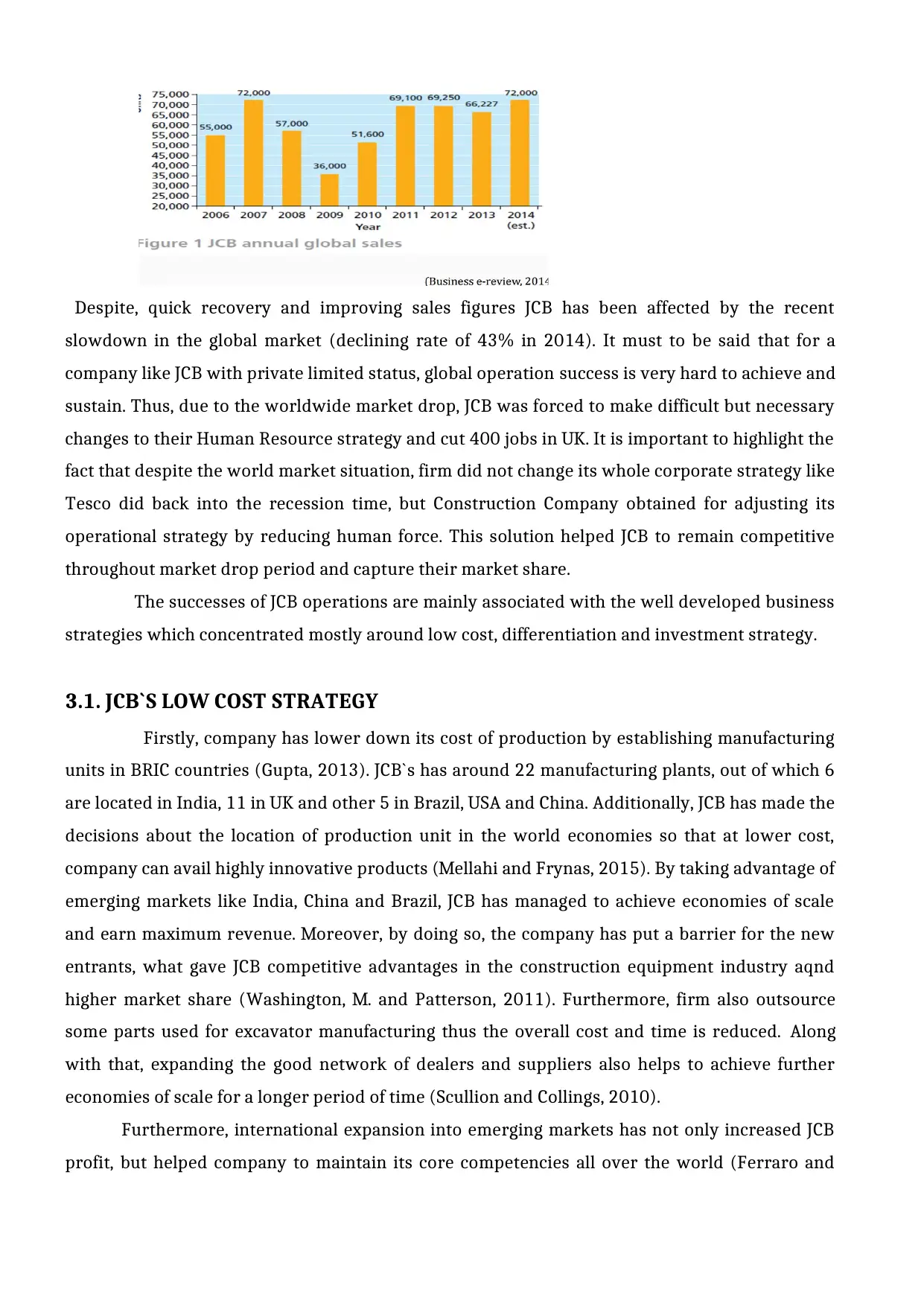
Despite, quick recovery and improving sales figures JCB has been affected by the recent
slowdown in the global market (declining rate of 43% in 2014). It must to be said that for a
company like JCB with private limited status, global operation success is very hard to achieve and
sustain. Thus, due to the worldwide market drop, JCB was forced to make difficult but necessary
changes to their Human Resource strategy and cut 400 jobs in UK. It is important to highlight the
fact that despite the world market situation, firm did not change its whole corporate strategy like
Tesco did back into the recession time, but Construction Company obtained for adjusting its
operational strategy by reducing human force. This solution helped JCB to remain competitive
throughout market drop period and capture their market share.
The successes of JCB operations are mainly associated with the well developed business
strategies which concentrated mostly around low cost, differentiation and investment strategy.
3.1. JCB`S LOW COST STRATEGY
Firstly, company has lower down its cost of production by establishing manufacturing
units in BRIC countries (Gupta, 2013). JCB`s has around 22 manufacturing plants, out of which 6
are located in India, 11 in UK and other 5 in Brazil, USA and China. Additionally, JCB has made the
decisions about the location of production unit in the world economies so that at lower cost,
company can avail highly innovative products (Mellahi and Frynas, 2015). By taking advantage of
emerging markets like India, China and Brazil, JCB has managed to achieve economies of scale
and earn maximum revenue. Moreover, by doing so, the company has put a barrier for the new
entrants, what gave JCB competitive advantages in the construction equipment industry aqnd
higher market share (Washington, M. and Patterson, 2011). Furthermore, firm also outsource
some parts used for excavator manufacturing thus the overall cost and time is reduced. Along
with that, expanding the good network of dealers and suppliers also helps to achieve further
economies of scale for a longer period of time (Scullion and Collings, 2010).
Furthermore, international expansion into emerging markets has not only increased JCB
profit, but helped company to maintain its core competencies all over the world (Ferraro and
slowdown in the global market (declining rate of 43% in 2014). It must to be said that for a
company like JCB with private limited status, global operation success is very hard to achieve and
sustain. Thus, due to the worldwide market drop, JCB was forced to make difficult but necessary
changes to their Human Resource strategy and cut 400 jobs in UK. It is important to highlight the
fact that despite the world market situation, firm did not change its whole corporate strategy like
Tesco did back into the recession time, but Construction Company obtained for adjusting its
operational strategy by reducing human force. This solution helped JCB to remain competitive
throughout market drop period and capture their market share.
The successes of JCB operations are mainly associated with the well developed business
strategies which concentrated mostly around low cost, differentiation and investment strategy.
3.1. JCB`S LOW COST STRATEGY
Firstly, company has lower down its cost of production by establishing manufacturing
units in BRIC countries (Gupta, 2013). JCB`s has around 22 manufacturing plants, out of which 6
are located in India, 11 in UK and other 5 in Brazil, USA and China. Additionally, JCB has made the
decisions about the location of production unit in the world economies so that at lower cost,
company can avail highly innovative products (Mellahi and Frynas, 2015). By taking advantage of
emerging markets like India, China and Brazil, JCB has managed to achieve economies of scale
and earn maximum revenue. Moreover, by doing so, the company has put a barrier for the new
entrants, what gave JCB competitive advantages in the construction equipment industry aqnd
higher market share (Washington, M. and Patterson, 2011). Furthermore, firm also outsource
some parts used for excavator manufacturing thus the overall cost and time is reduced. Along
with that, expanding the good network of dealers and suppliers also helps to achieve further
economies of scale for a longer period of time (Scullion and Collings, 2010).
Furthermore, international expansion into emerging markets has not only increased JCB
profit, but helped company to maintain its core competencies all over the world (Ferraro and
Paraphrase This Document
Need a fresh take? Get an instant paraphrase of this document with our AI Paraphraser
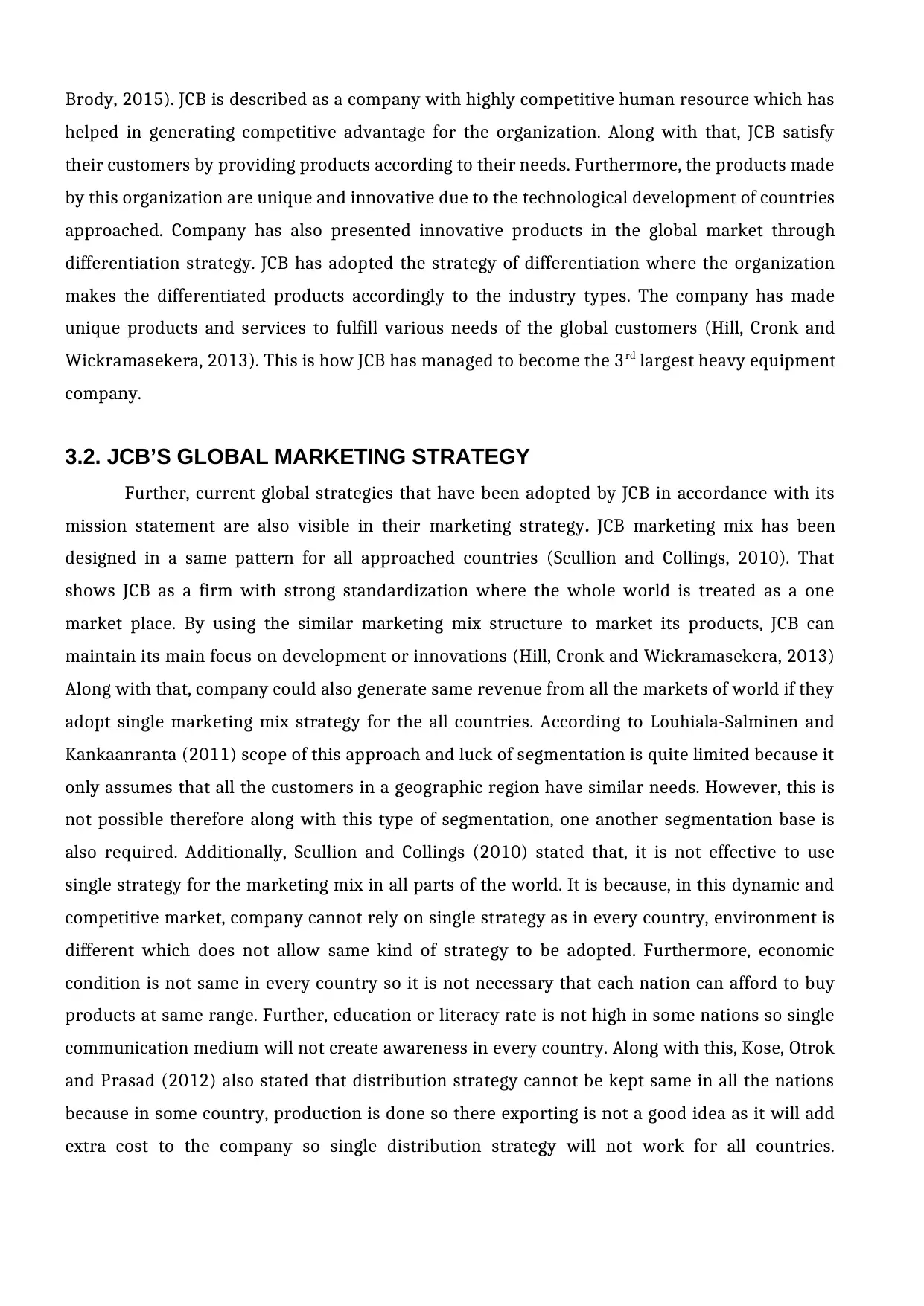
Brody, 2015). JCB is described as a company with highly competitive human resource which has
helped in generating competitive advantage for the organization. Along with that, JCB satisfy
their customers by providing products according to their needs. Furthermore, the products made
by this organization are unique and innovative due to the technological development of countries
approached. Company has also presented innovative products in the global market through
differentiation strategy. JCB has adopted the strategy of differentiation where the organization
makes the differentiated products accordingly to the industry types. The company has made
unique products and services to fulfill various needs of the global customers (Hill, Cronk and
Wickramasekera, 2013). This is how JCB has managed to become the 3rd largest heavy equipment
company.
3.2. JCB’S GLOBAL MARKETING STRATEGY
Further, current global strategies that have been adopted by JCB in accordance with its
mission statement are also visible in their marketing strategy. JCB marketing mix has been
designed in a same pattern for all approached countries (Scullion and Collings, 2010). That
shows JCB as a firm with strong standardization where the whole world is treated as a one
market place. By using the similar marketing mix structure to market its products, JCB can
maintain its main focus on development or innovations (Hill, Cronk and Wickramasekera, 2013)
Along with that, company could also generate same revenue from all the markets of world if they
adopt single marketing mix strategy for the all countries. According to Louhiala-Salminen and
Kankaanranta (2011) scope of this approach and luck of segmentation is quite limited because it
only assumes that all the customers in a geographic region have similar needs. However, this is
not possible therefore along with this type of segmentation, one another segmentation base is
also required. Additionally, Scullion and Collings (2010) stated that, it is not effective to use
single strategy for the marketing mix in all parts of the world. It is because, in this dynamic and
competitive market, company cannot rely on single strategy as in every country, environment is
different which does not allow same kind of strategy to be adopted. Furthermore, economic
condition is not same in every country so it is not necessary that each nation can afford to buy
products at same range. Further, education or literacy rate is not high in some nations so single
communication medium will not create awareness in every country. Along with this, Kose, Otrok
and Prasad (2012) also stated that distribution strategy cannot be kept same in all the nations
because in some country, production is done so there exporting is not a good idea as it will add
extra cost to the company so single distribution strategy will not work for all countries.
helped in generating competitive advantage for the organization. Along with that, JCB satisfy
their customers by providing products according to their needs. Furthermore, the products made
by this organization are unique and innovative due to the technological development of countries
approached. Company has also presented innovative products in the global market through
differentiation strategy. JCB has adopted the strategy of differentiation where the organization
makes the differentiated products accordingly to the industry types. The company has made
unique products and services to fulfill various needs of the global customers (Hill, Cronk and
Wickramasekera, 2013). This is how JCB has managed to become the 3rd largest heavy equipment
company.
3.2. JCB’S GLOBAL MARKETING STRATEGY
Further, current global strategies that have been adopted by JCB in accordance with its
mission statement are also visible in their marketing strategy. JCB marketing mix has been
designed in a same pattern for all approached countries (Scullion and Collings, 2010). That
shows JCB as a firm with strong standardization where the whole world is treated as a one
market place. By using the similar marketing mix structure to market its products, JCB can
maintain its main focus on development or innovations (Hill, Cronk and Wickramasekera, 2013)
Along with that, company could also generate same revenue from all the markets of world if they
adopt single marketing mix strategy for the all countries. According to Louhiala-Salminen and
Kankaanranta (2011) scope of this approach and luck of segmentation is quite limited because it
only assumes that all the customers in a geographic region have similar needs. However, this is
not possible therefore along with this type of segmentation, one another segmentation base is
also required. Additionally, Scullion and Collings (2010) stated that, it is not effective to use
single strategy for the marketing mix in all parts of the world. It is because, in this dynamic and
competitive market, company cannot rely on single strategy as in every country, environment is
different which does not allow same kind of strategy to be adopted. Furthermore, economic
condition is not same in every country so it is not necessary that each nation can afford to buy
products at same range. Further, education or literacy rate is not high in some nations so single
communication medium will not create awareness in every country. Along with this, Kose, Otrok
and Prasad (2012) also stated that distribution strategy cannot be kept same in all the nations
because in some country, production is done so there exporting is not a good idea as it will add
extra cost to the company so single distribution strategy will not work for all countries.

Moreover, pricing strategy made by the company is also almost similar in all the countries. At
first, it helps firm to get equal revenue from all the countries. Secondly, JCB`s strategy of
standardization also helped company to become the industry leader in global market. Further,
firm uses various communication channels and languages to reduce the language barriers and
reach larger markets.
In addition, JCB is making use of marketing orientation strategy for making decisions at
the same time considering customer's demand (Gupta, 2013). The organization is concerned on
construction and agricultural sectors fields and its mission is to grow the company by providing
innovative, strong and high performance vehicles that can satisfy the needs to globe customers.
The herewith mentioned company is going to improve technology so that customers can be
provided with strong and high performance products. The excellent services provided by the
company are the reason for which company has gained third place in the market. In accordance
to the marketing strategies, the company is focused on applying the best marketing practices. It
focuses on defining target consumers, monitoring competition, evaluating customer value and
gaining customers feedback. In order to market the product the company goes for advertising
through the trade publications.
Moreover, Joseph Cyril Bamford`s firm is an investment orient company where
investments are the key business strategy. It must be mentioned that 3% of JCB annual turnover
is spend on Research and Development which helps business in planning for effective future
projects. Most importantly, various investment projects are used by JCB as a strong marketing
tool. For example, it has been recently announced that JCB is to build £30 million golf course in
Rocester. Firstly, this golf course construction project will expose JCB globally what will give
business a greatest marketing opportunity. Secondly, the project will attract many global dealers
and investors thus firm will get a long term benefit due to international golf tournaments
(Brown, 2015). Additionally, firm makes its investment not only in emerging markets like China
or Russia but others too. Countries like Bulgaria, Romania, Poland, proved to be a great source of
business growth during 2007 (Peng, 2015). Moreover, investments in other countries than BRIC
economies helped JCB to reduce the reliance on UK economy in case of domestic market crisis.
Furthermore, by doing investment in the diverse countries, JCB managed to capture more than
half of the foreign market.
In terms of products, JCB marketing mix practices are concentrated on prime quality of
products and mainly base on that the firm was able to gain huge market share. In addition to
first, it helps firm to get equal revenue from all the countries. Secondly, JCB`s strategy of
standardization also helped company to become the industry leader in global market. Further,
firm uses various communication channels and languages to reduce the language barriers and
reach larger markets.
In addition, JCB is making use of marketing orientation strategy for making decisions at
the same time considering customer's demand (Gupta, 2013). The organization is concerned on
construction and agricultural sectors fields and its mission is to grow the company by providing
innovative, strong and high performance vehicles that can satisfy the needs to globe customers.
The herewith mentioned company is going to improve technology so that customers can be
provided with strong and high performance products. The excellent services provided by the
company are the reason for which company has gained third place in the market. In accordance
to the marketing strategies, the company is focused on applying the best marketing practices. It
focuses on defining target consumers, monitoring competition, evaluating customer value and
gaining customers feedback. In order to market the product the company goes for advertising
through the trade publications.
Moreover, Joseph Cyril Bamford`s firm is an investment orient company where
investments are the key business strategy. It must be mentioned that 3% of JCB annual turnover
is spend on Research and Development which helps business in planning for effective future
projects. Most importantly, various investment projects are used by JCB as a strong marketing
tool. For example, it has been recently announced that JCB is to build £30 million golf course in
Rocester. Firstly, this golf course construction project will expose JCB globally what will give
business a greatest marketing opportunity. Secondly, the project will attract many global dealers
and investors thus firm will get a long term benefit due to international golf tournaments
(Brown, 2015). Additionally, firm makes its investment not only in emerging markets like China
or Russia but others too. Countries like Bulgaria, Romania, Poland, proved to be a great source of
business growth during 2007 (Peng, 2015). Moreover, investments in other countries than BRIC
economies helped JCB to reduce the reliance on UK economy in case of domestic market crisis.
Furthermore, by doing investment in the diverse countries, JCB managed to capture more than
half of the foreign market.
In terms of products, JCB marketing mix practices are concentrated on prime quality of
products and mainly base on that the firm was able to gain huge market share. In addition to
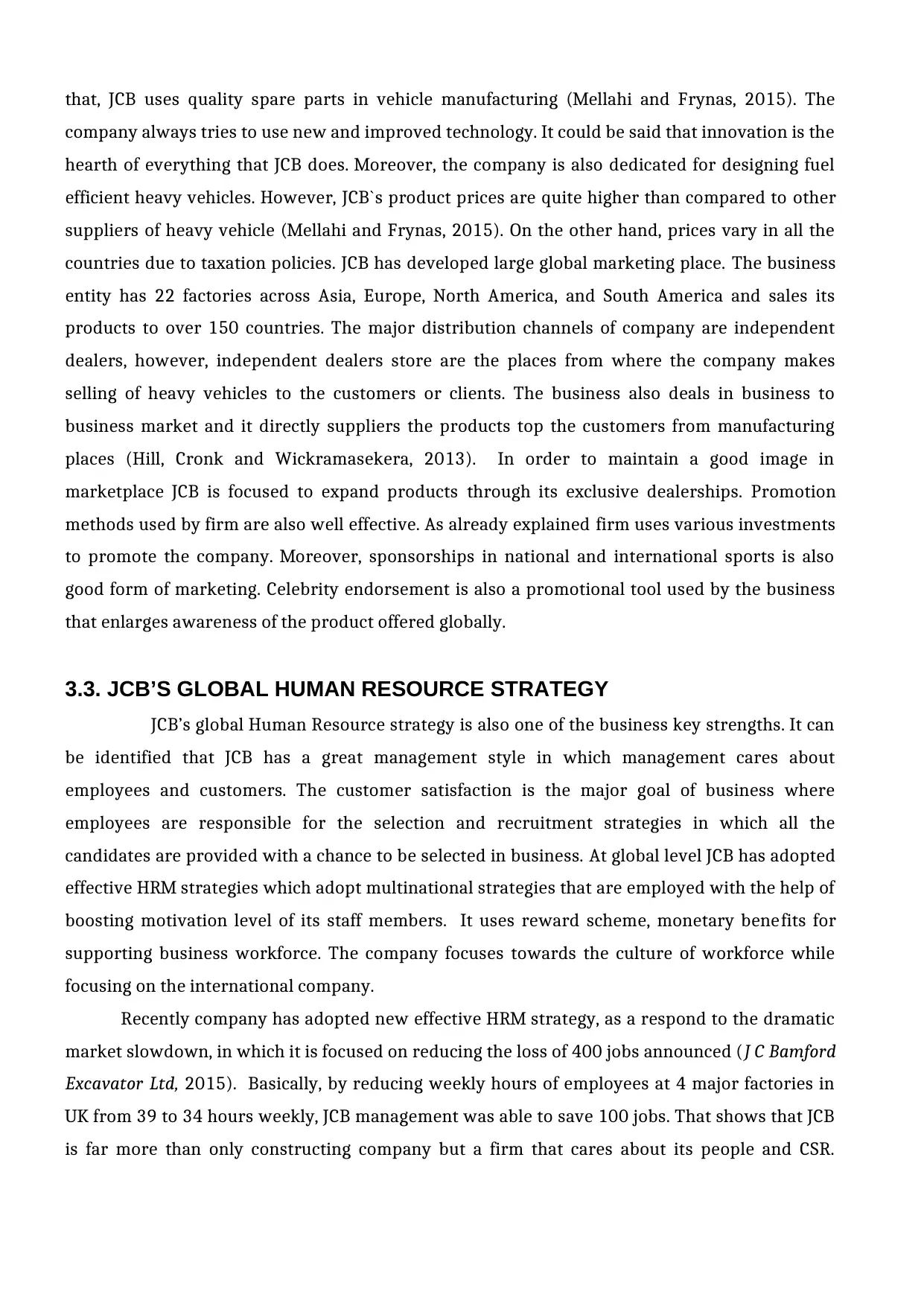
that, JCB uses quality spare parts in vehicle manufacturing (Mellahi and Frynas, 2015). The
company always tries to use new and improved technology. It could be said that innovation is the
hearth of everything that JCB does. Moreover, the company is also dedicated for designing fuel
efficient heavy vehicles. However, JCB`s product prices are quite higher than compared to other
suppliers of heavy vehicle (Mellahi and Frynas, 2015). On the other hand, prices vary in all the
countries due to taxation policies. JCB has developed large global marketing place. The business
entity has 22 factories across Asia, Europe, North America, and South America and sales its
products to over 150 countries. The major distribution channels of company are independent
dealers, however, independent dealers store are the places from where the company makes
selling of heavy vehicles to the customers or clients. The business also deals in business to
business market and it directly suppliers the products top the customers from manufacturing
places (Hill, Cronk and Wickramasekera, 2013). In order to maintain a good image in
marketplace JCB is focused to expand products through its exclusive dealerships. Promotion
methods used by firm are also well effective. As already explained firm uses various investments
to promote the company. Moreover, sponsorships in national and international sports is also
good form of marketing. Celebrity endorsement is also a promotional tool used by the business
that enlarges awareness of the product offered globally.
3.3. JCB’S GLOBAL HUMAN RESOURCE STRATEGY
JCB’s global Human Resource strategy is also one of the business key strengths. It can
be identified that JCB has a great management style in which management cares about
employees and customers. The customer satisfaction is the major goal of business where
employees are responsible for the selection and recruitment strategies in which all the
candidates are provided with a chance to be selected in business. At global level JCB has adopted
effective HRM strategies which adopt multinational strategies that are employed with the help of
boosting motivation level of its staff members. It uses reward scheme, monetary benefits for
supporting business workforce. The company focuses towards the culture of workforce while
focusing on the international company.
Recently company has adopted new effective HRM strategy, as a respond to the dramatic
market slowdown, in which it is focused on reducing the loss of 400 jobs announced (J C Bamford
Excavator Ltd, 2015). Basically, by reducing weekly hours of employees at 4 major factories in
UK from 39 to 34 hours weekly, JCB management was able to save 100 jobs. That shows that JCB
is far more than only constructing company but a firm that cares about its people and CSR.
company always tries to use new and improved technology. It could be said that innovation is the
hearth of everything that JCB does. Moreover, the company is also dedicated for designing fuel
efficient heavy vehicles. However, JCB`s product prices are quite higher than compared to other
suppliers of heavy vehicle (Mellahi and Frynas, 2015). On the other hand, prices vary in all the
countries due to taxation policies. JCB has developed large global marketing place. The business
entity has 22 factories across Asia, Europe, North America, and South America and sales its
products to over 150 countries. The major distribution channels of company are independent
dealers, however, independent dealers store are the places from where the company makes
selling of heavy vehicles to the customers or clients. The business also deals in business to
business market and it directly suppliers the products top the customers from manufacturing
places (Hill, Cronk and Wickramasekera, 2013). In order to maintain a good image in
marketplace JCB is focused to expand products through its exclusive dealerships. Promotion
methods used by firm are also well effective. As already explained firm uses various investments
to promote the company. Moreover, sponsorships in national and international sports is also
good form of marketing. Celebrity endorsement is also a promotional tool used by the business
that enlarges awareness of the product offered globally.
3.3. JCB’S GLOBAL HUMAN RESOURCE STRATEGY
JCB’s global Human Resource strategy is also one of the business key strengths. It can
be identified that JCB has a great management style in which management cares about
employees and customers. The customer satisfaction is the major goal of business where
employees are responsible for the selection and recruitment strategies in which all the
candidates are provided with a chance to be selected in business. At global level JCB has adopted
effective HRM strategies which adopt multinational strategies that are employed with the help of
boosting motivation level of its staff members. It uses reward scheme, monetary benefits for
supporting business workforce. The company focuses towards the culture of workforce while
focusing on the international company.
Recently company has adopted new effective HRM strategy, as a respond to the dramatic
market slowdown, in which it is focused on reducing the loss of 400 jobs announced (J C Bamford
Excavator Ltd, 2015). Basically, by reducing weekly hours of employees at 4 major factories in
UK from 39 to 34 hours weekly, JCB management was able to save 100 jobs. That shows that JCB
is far more than only constructing company but a firm that cares about its people and CSR.
Secure Best Marks with AI Grader
Need help grading? Try our AI Grader for instant feedback on your assignments.
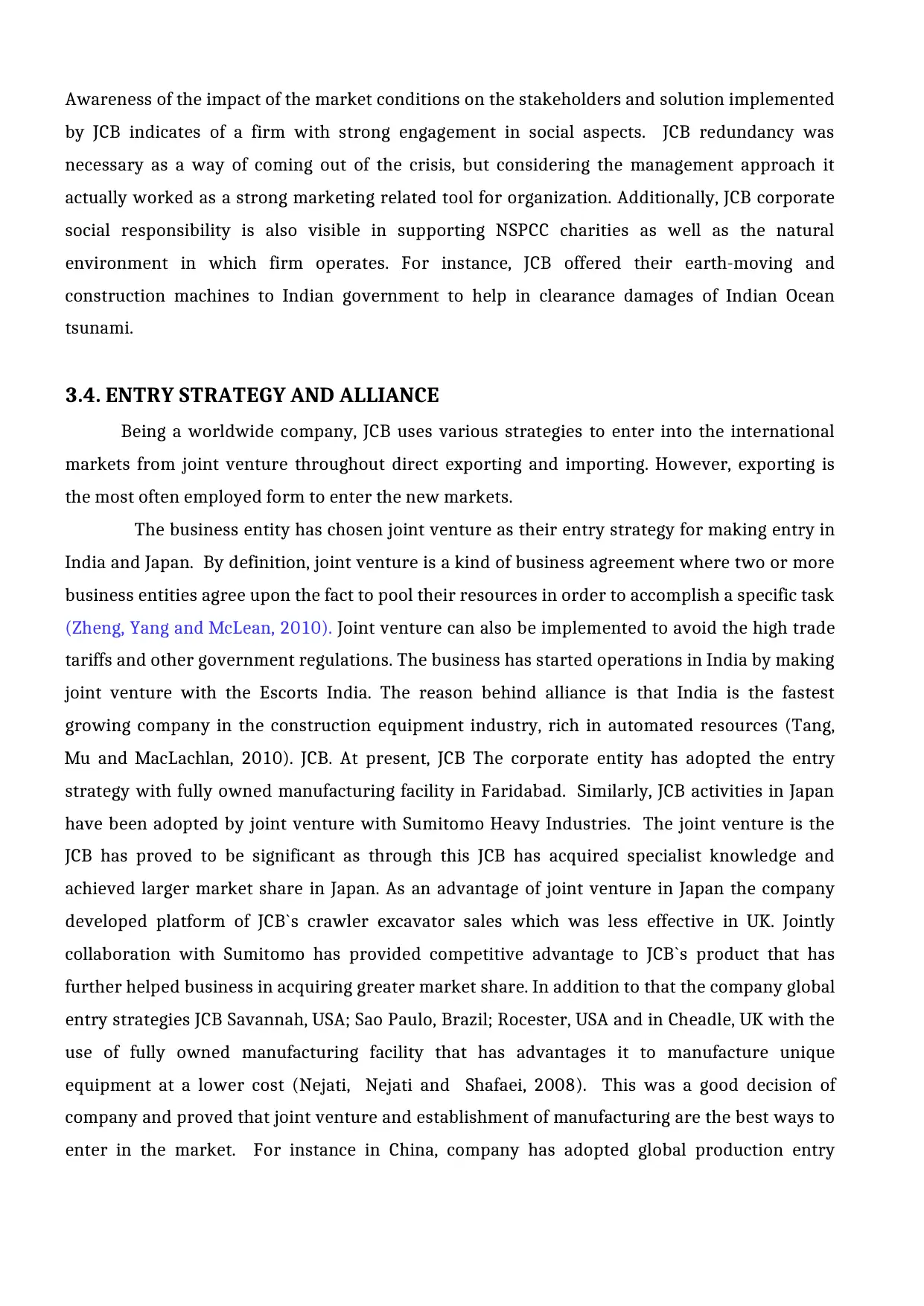
Awareness of the impact of the market conditions on the stakeholders and solution implemented
by JCB indicates of a firm with strong engagement in social aspects. JCB redundancy was
necessary as a way of coming out of the crisis, but considering the management approach it
actually worked as a strong marketing related tool for organization. Additionally, JCB corporate
social responsibility is also visible in supporting NSPCC charities as well as the natural
environment in which firm operates. For instance, JCB offered their earth-moving and
construction machines to Indian government to help in clearance damages of Indian Ocean
tsunami.
3.4. ENTRY STRATEGY AND ALLIANCE
Being a worldwide company, JCB uses various strategies to enter into the international
markets from joint venture throughout direct exporting and importing. However, exporting is
the most often employed form to enter the new markets.
The business entity has chosen joint venture as their entry strategy for making entry in
India and Japan. By definition, joint venture is a kind of business agreement where two or more
business entities agree upon the fact to pool their resources in order to accomplish a specific task
(Zheng, Yang and McLean, 2010). Joint venture can also be implemented to avoid the high trade
tariffs and other government regulations. The business has started operations in India by making
joint venture with the Escorts India. The reason behind alliance is that India is the fastest
growing company in the construction equipment industry, rich in automated resources (Tang,
Mu and MacLachlan, 2010). JCB. At present, JCB The corporate entity has adopted the entry
strategy with fully owned manufacturing facility in Faridabad. Similarly, JCB activities in Japan
have been adopted by joint venture with Sumitomo Heavy Industries. The joint venture is the
JCB has proved to be significant as through this JCB has acquired specialist knowledge and
achieved larger market share in Japan. As an advantage of joint venture in Japan the company
developed platform of JCB`s crawler excavator sales which was less effective in UK. Jointly
collaboration with Sumitomo has provided competitive advantage to JCB`s product that has
further helped business in acquiring greater market share. In addition to that the company global
entry strategies JCB Savannah, USA; Sao Paulo, Brazil; Rocester, USA and in Cheadle, UK with the
use of fully owned manufacturing facility that has advantages it to manufacture unique
equipment at a lower cost (Nejati, Nejati and Shafaei, 2008). This was a good decision of
company and proved that joint venture and establishment of manufacturing are the best ways to
enter in the market. For instance in China, company has adopted global production entry
by JCB indicates of a firm with strong engagement in social aspects. JCB redundancy was
necessary as a way of coming out of the crisis, but considering the management approach it
actually worked as a strong marketing related tool for organization. Additionally, JCB corporate
social responsibility is also visible in supporting NSPCC charities as well as the natural
environment in which firm operates. For instance, JCB offered their earth-moving and
construction machines to Indian government to help in clearance damages of Indian Ocean
tsunami.
3.4. ENTRY STRATEGY AND ALLIANCE
Being a worldwide company, JCB uses various strategies to enter into the international
markets from joint venture throughout direct exporting and importing. However, exporting is
the most often employed form to enter the new markets.
The business entity has chosen joint venture as their entry strategy for making entry in
India and Japan. By definition, joint venture is a kind of business agreement where two or more
business entities agree upon the fact to pool their resources in order to accomplish a specific task
(Zheng, Yang and McLean, 2010). Joint venture can also be implemented to avoid the high trade
tariffs and other government regulations. The business has started operations in India by making
joint venture with the Escorts India. The reason behind alliance is that India is the fastest
growing company in the construction equipment industry, rich in automated resources (Tang,
Mu and MacLachlan, 2010). JCB. At present, JCB The corporate entity has adopted the entry
strategy with fully owned manufacturing facility in Faridabad. Similarly, JCB activities in Japan
have been adopted by joint venture with Sumitomo Heavy Industries. The joint venture is the
JCB has proved to be significant as through this JCB has acquired specialist knowledge and
achieved larger market share in Japan. As an advantage of joint venture in Japan the company
developed platform of JCB`s crawler excavator sales which was less effective in UK. Jointly
collaboration with Sumitomo has provided competitive advantage to JCB`s product that has
further helped business in acquiring greater market share. In addition to that the company global
entry strategies JCB Savannah, USA; Sao Paulo, Brazil; Rocester, USA and in Cheadle, UK with the
use of fully owned manufacturing facility that has advantages it to manufacture unique
equipment at a lower cost (Nejati, Nejati and Shafaei, 2008). This was a good decision of
company and proved that joint venture and establishment of manufacturing are the best ways to
enter in the market. For instance in China, company has adopted global production entry

strategy. Due to the high market demand, company opened its own manufacturing plant where
250,000 construction machines are sold every year.
4.0. RECOMMENDATIONS FOR JCB
While operating in the global market JCB will face large number of challenges
however there are many growth and development opportunities too. Firstly, economic condition
of different market is one of the main challenges faced by company. It is well known that
economic condition of approached market may bring different outcomes for company like JCB.
Economic condition either allows business to indulge into more innovative (Ferraro and Brody,
2015). Thus it is advisable to take advantage of countries like China, US or India which are
predicted to account 57% of all global construction and engineering market. Moreover, due to
the Chinese society ageing, it is stated that by 2030 there will be a need of modernization in
hospitality sectors thus JCB can benefit from it (Zhou,J., 2013). Second huge market opportunity
for JCB`s growth is associated with the Indian government announcement to increase the
investment in new cities infrastructure and transports by 2020 (Scullion and Collings, 2013) The
business entity can also adopt merger and acquisition strategies for entering in new markets.
With the help of this strategy, JCB can acquire construction company at the less cost in
international markets.
On the other hand, negative political situation can cause slowdown in the emerging
market what will prevent JCB from accomplishing its major goals and objectives. For example, as
seen in Brazil, corruption and political scandals cause the slowdown the construction growth
what has impact on JCB`s sales figure (Watts, 2016). Thus, difference in the targeted market
condition or requirements must be taken in consideration by JCB management as all the
products may not be acceptable in every market. For instance, in developed nations advanced
machinery is used for construction purpose as compared with other nation such as India it might
not be functional (Zheng, Yang and McLean, 2010). Diversity is one of the main issues at JCB.
Therefore, modification of the product range as per requirement of the target market is a must
for JCB as standardization may have negative impact on performance of company in the long
term. JCB has to consider need and requirement of different markets.
Apart from this, due to redundancy and activities carried out by JCB workforce i.e. employees
may not feel secured. Therefore, business has to search for effective ways through which
individuals within the organization can feel comfortable while working at the workplace. This
250,000 construction machines are sold every year.
4.0. RECOMMENDATIONS FOR JCB
While operating in the global market JCB will face large number of challenges
however there are many growth and development opportunities too. Firstly, economic condition
of different market is one of the main challenges faced by company. It is well known that
economic condition of approached market may bring different outcomes for company like JCB.
Economic condition either allows business to indulge into more innovative (Ferraro and Brody,
2015). Thus it is advisable to take advantage of countries like China, US or India which are
predicted to account 57% of all global construction and engineering market. Moreover, due to
the Chinese society ageing, it is stated that by 2030 there will be a need of modernization in
hospitality sectors thus JCB can benefit from it (Zhou,J., 2013). Second huge market opportunity
for JCB`s growth is associated with the Indian government announcement to increase the
investment in new cities infrastructure and transports by 2020 (Scullion and Collings, 2013) The
business entity can also adopt merger and acquisition strategies for entering in new markets.
With the help of this strategy, JCB can acquire construction company at the less cost in
international markets.
On the other hand, negative political situation can cause slowdown in the emerging
market what will prevent JCB from accomplishing its major goals and objectives. For example, as
seen in Brazil, corruption and political scandals cause the slowdown the construction growth
what has impact on JCB`s sales figure (Watts, 2016). Thus, difference in the targeted market
condition or requirements must be taken in consideration by JCB management as all the
products may not be acceptable in every market. For instance, in developed nations advanced
machinery is used for construction purpose as compared with other nation such as India it might
not be functional (Zheng, Yang and McLean, 2010). Diversity is one of the main issues at JCB.
Therefore, modification of the product range as per requirement of the target market is a must
for JCB as standardization may have negative impact on performance of company in the long
term. JCB has to consider need and requirement of different markets.
Apart from this, due to redundancy and activities carried out by JCB workforce i.e. employees
may not feel secured. Therefore, business has to search for effective ways through which
individuals within the organization can feel comfortable while working at the workplace. This
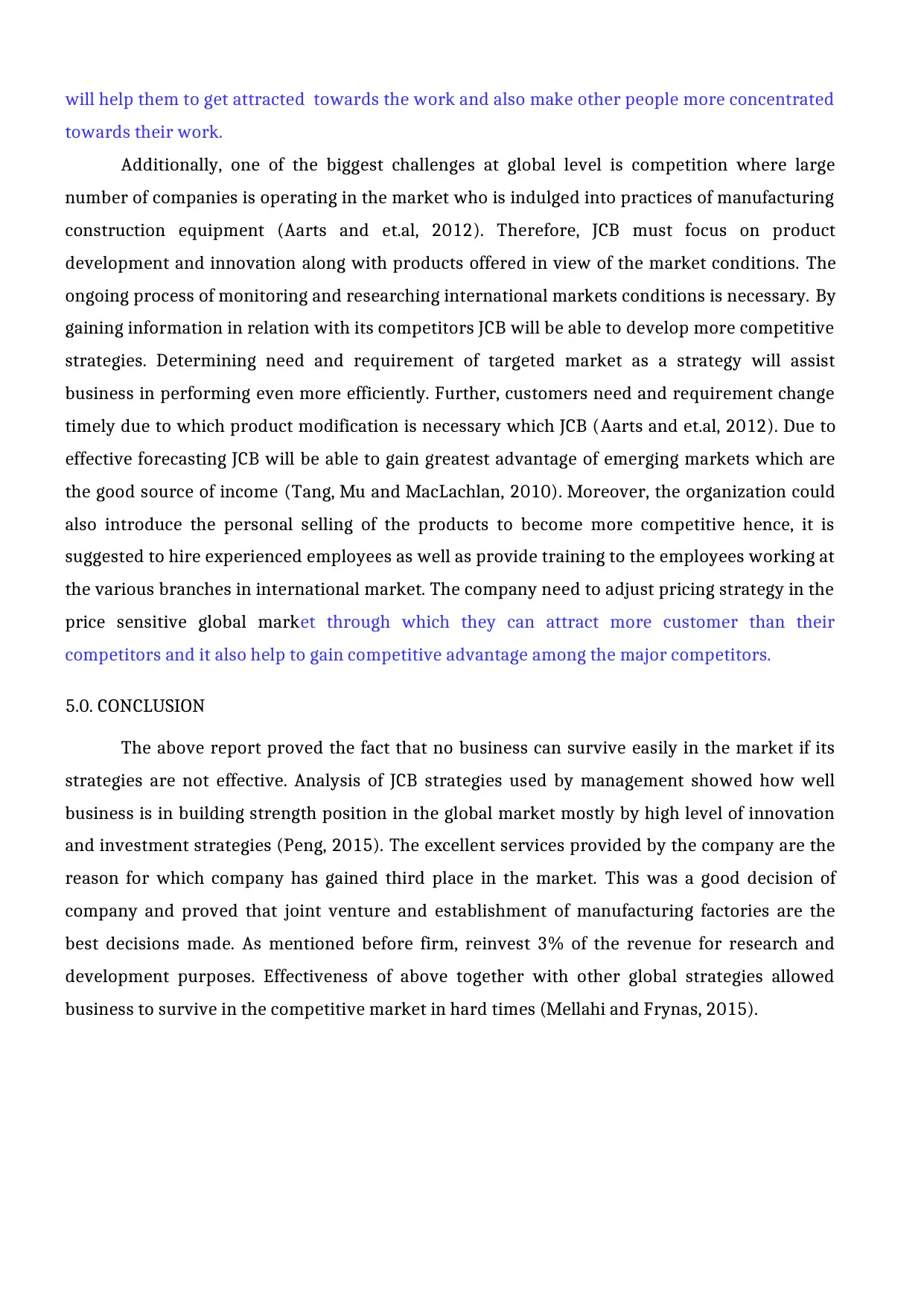
will help them to get attracted towards the work and also make other people more concentrated
towards their work.
Additionally, one of the biggest challenges at global level is competition where large
number of companies is operating in the market who is indulged into practices of manufacturing
construction equipment (Aarts and et.al, 2012). Therefore, JCB must focus on product
development and innovation along with products offered in view of the market conditions. The
ongoing process of monitoring and researching international markets conditions is necessary. By
gaining information in relation with its competitors JCB will be able to develop more competitive
strategies. Determining need and requirement of targeted market as a strategy will assist
business in performing even more efficiently. Further, customers need and requirement change
timely due to which product modification is necessary which JCB (Aarts and et.al, 2012). Due to
effective forecasting JCB will be able to gain greatest advantage of emerging markets which are
the good source of income (Tang, Mu and MacLachlan, 2010). Moreover, the organization could
also introduce the personal selling of the products to become more competitive hence, it is
suggested to hire experienced employees as well as provide training to the employees working at
the various branches in international market. The company need to adjust pricing strategy in the
price sensitive global market through which they can attract more customer than their
competitors and it also help to gain competitive advantage among the major competitors.
5.0. CONCLUSION
The above report proved the fact that no business can survive easily in the market if its
strategies are not effective. Analysis of JCB strategies used by management showed how well
business is in building strength position in the global market mostly by high level of innovation
and investment strategies (Peng, 2015). The excellent services provided by the company are the
reason for which company has gained third place in the market. This was a good decision of
company and proved that joint venture and establishment of manufacturing factories are the
best decisions made. As mentioned before firm, reinvest 3% of the revenue for research and
development purposes. Effectiveness of above together with other global strategies allowed
business to survive in the competitive market in hard times (Mellahi and Frynas, 2015).
towards their work.
Additionally, one of the biggest challenges at global level is competition where large
number of companies is operating in the market who is indulged into practices of manufacturing
construction equipment (Aarts and et.al, 2012). Therefore, JCB must focus on product
development and innovation along with products offered in view of the market conditions. The
ongoing process of monitoring and researching international markets conditions is necessary. By
gaining information in relation with its competitors JCB will be able to develop more competitive
strategies. Determining need and requirement of targeted market as a strategy will assist
business in performing even more efficiently. Further, customers need and requirement change
timely due to which product modification is necessary which JCB (Aarts and et.al, 2012). Due to
effective forecasting JCB will be able to gain greatest advantage of emerging markets which are
the good source of income (Tang, Mu and MacLachlan, 2010). Moreover, the organization could
also introduce the personal selling of the products to become more competitive hence, it is
suggested to hire experienced employees as well as provide training to the employees working at
the various branches in international market. The company need to adjust pricing strategy in the
price sensitive global market through which they can attract more customer than their
competitors and it also help to gain competitive advantage among the major competitors.
5.0. CONCLUSION
The above report proved the fact that no business can survive easily in the market if its
strategies are not effective. Analysis of JCB strategies used by management showed how well
business is in building strength position in the global market mostly by high level of innovation
and investment strategies (Peng, 2015). The excellent services provided by the company are the
reason for which company has gained third place in the market. This was a good decision of
company and proved that joint venture and establishment of manufacturing factories are the
best decisions made. As mentioned before firm, reinvest 3% of the revenue for research and
development purposes. Effectiveness of above together with other global strategies allowed
business to survive in the competitive market in hard times (Mellahi and Frynas, 2015).
Paraphrase This Document
Need a fresh take? Get an instant paraphrase of this document with our AI Paraphraser

6.0. REFERENCES
Journals and Books
Aarts, M. and et.al., 2012. Forced mitotic entry of S-phase cells as a therapeutic strategy induced
by inhibition of WEE1. Cancer discovery. 2(6). pp.524-539.
Cavusgil, S. T. and et.al., 2014. International business. Pearson Australia.
Ferraro, G. and Brody, E. K., 2015. Cultural Dimension of Global Business. Routledge.
Gupta, P. K., 2013. Mergers and acquisitions (m&a): the strategic concepts for the nuptials of
corporate sector. Innovative Journal of Business and Management. 1(4). pp.580-600
Hill, C. W., Cronk, T. and Wickramasekera, R., 2013. Global business today. McGraw-Hill
Education..
Kittilaksanawong, W., 2011. FDIs by high-tech firms from newly-industrialized economies in
emerging markets: The role of resources on entry strategy. African Journal of Business
Management. 5(4). p.1146.
Kose, M. A., Otrok, C. and Prasad, E., 2012. Global Business Cycles: Convergence or Decoupling?*.
International Economic Review. 53(2). pp.511-538.
Louhiala-Salminen, L. and Kankaanranta, A., 2011. Professional communication in a global
business context: The notion of global communicative competence. Professional
Communication, IEEE Transactions on. 54(3). pp.244-262.
Mellahi, K. and Frynas, G., 2015. Global strategic management. Oxford University Press.
Nejati, M., Nejati, N and Shafaei, A., 2008. Issues in Global Business and Management Research:
Proceedings of the 2008 International Online Conference on Business and Management
(IOCBM 2008). Universal-Publishers.
Peng, M., 2015. Global business. Nelson Education.
Scullion, H. and Collings, D., 2010. Global talent management. Routledge.
Tang, F., Mu, J. and MacLachlan, D. L., 2010. Disseminative capacity, organizational structure and
knowledge transfer. Expert Systems with Applications. 37(2). pp.1586-1593.
Washington, M. and Patterson, K.D., 2011. Hostile takeover or joint venture: Connections
between institutional theory and sport management research. Sport Management Review.
14(1). pp.1-12.
Journals and Books
Aarts, M. and et.al., 2012. Forced mitotic entry of S-phase cells as a therapeutic strategy induced
by inhibition of WEE1. Cancer discovery. 2(6). pp.524-539.
Cavusgil, S. T. and et.al., 2014. International business. Pearson Australia.
Ferraro, G. and Brody, E. K., 2015. Cultural Dimension of Global Business. Routledge.
Gupta, P. K., 2013. Mergers and acquisitions (m&a): the strategic concepts for the nuptials of
corporate sector. Innovative Journal of Business and Management. 1(4). pp.580-600
Hill, C. W., Cronk, T. and Wickramasekera, R., 2013. Global business today. McGraw-Hill
Education..
Kittilaksanawong, W., 2011. FDIs by high-tech firms from newly-industrialized economies in
emerging markets: The role of resources on entry strategy. African Journal of Business
Management. 5(4). p.1146.
Kose, M. A., Otrok, C. and Prasad, E., 2012. Global Business Cycles: Convergence or Decoupling?*.
International Economic Review. 53(2). pp.511-538.
Louhiala-Salminen, L. and Kankaanranta, A., 2011. Professional communication in a global
business context: The notion of global communicative competence. Professional
Communication, IEEE Transactions on. 54(3). pp.244-262.
Mellahi, K. and Frynas, G., 2015. Global strategic management. Oxford University Press.
Nejati, M., Nejati, N and Shafaei, A., 2008. Issues in Global Business and Management Research:
Proceedings of the 2008 International Online Conference on Business and Management
(IOCBM 2008). Universal-Publishers.
Peng, M., 2015. Global business. Nelson Education.
Scullion, H. and Collings, D., 2010. Global talent management. Routledge.
Tang, F., Mu, J. and MacLachlan, D. L., 2010. Disseminative capacity, organizational structure and
knowledge transfer. Expert Systems with Applications. 37(2). pp.1586-1593.
Washington, M. and Patterson, K.D., 2011. Hostile takeover or joint venture: Connections
between institutional theory and sport management research. Sport Management Review.
14(1). pp.1-12.
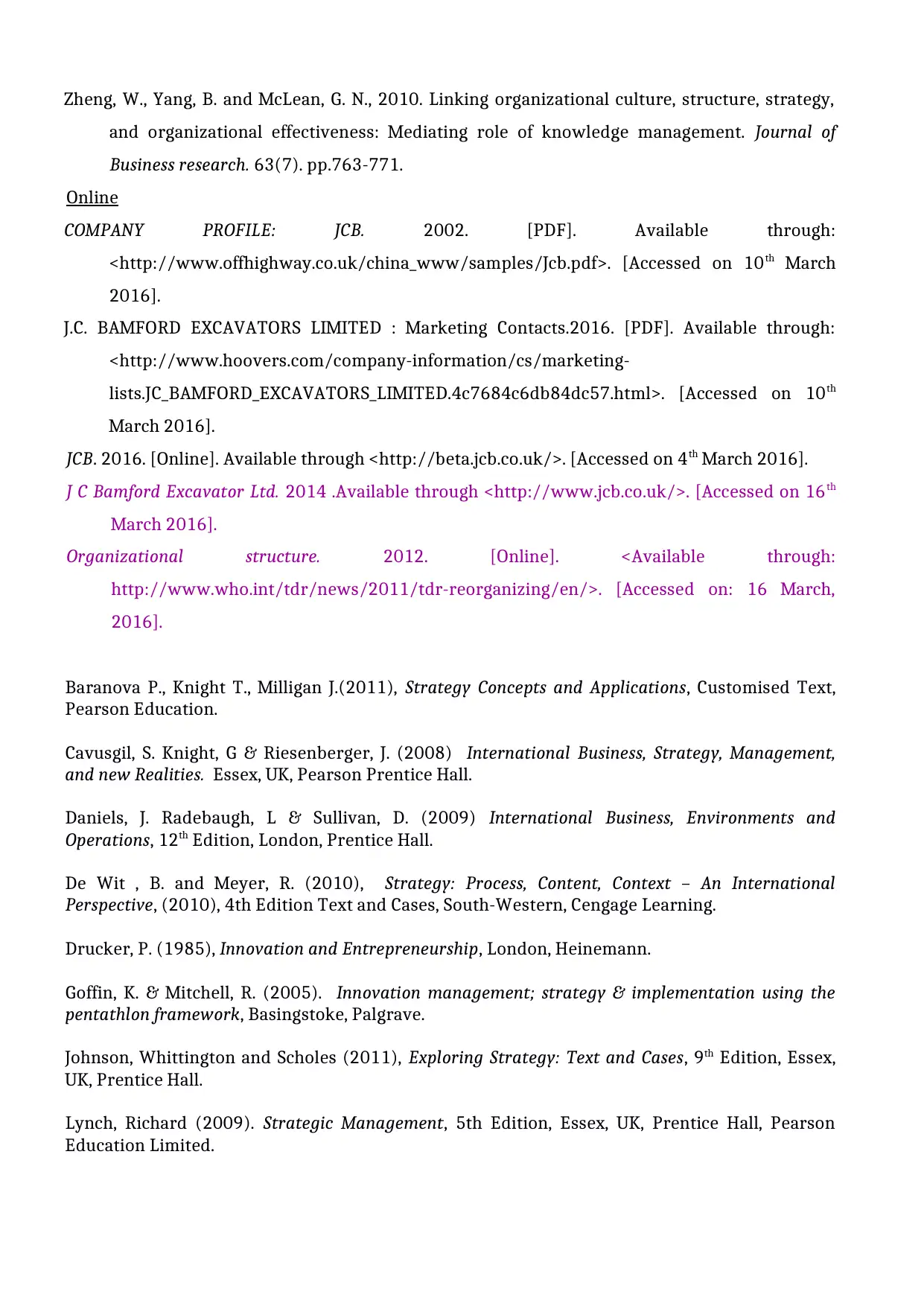
Zheng, W., Yang, B. and McLean, G. N., 2010. Linking organizational culture, structure, strategy,
and organizational effectiveness: Mediating role of knowledge management. Journal of
Business research. 63(7). pp.763-771.
Online
COMPANY PROFILE: JCB. 2002. [PDF]. Available through:
<http://www.offhighway.co.uk/china_www/samples/Jcb.pdf>. [Accessed on 10th March
2016].
J.C. BAMFORD EXCAVATORS LIMITED : Marketing Contacts.2016. [PDF]. Available through:
<http://www.hoovers.com/company-information/cs/marketing-
lists.JC_BAMFORD_EXCAVATORS_LIMITED.4c7684c6db84dc57.html>. [Accessed on 10th
March 2016].
JCB. 2016. [Online]. Available through <http://beta.jcb.co.uk/>. [Accessed on 4th March 2016].
J C Bamford Excavator Ltd. 2014 .Available through <http://www.jcb.co.uk/>. [Accessed on 16th
March 2016].
Organizational structure. 2012. [Online]. <Available through:
http://www.who.int/tdr/news/2011/tdr-reorganizing/en/>. [Accessed on: 16 March,
2016].
Baranova P., Knight T., Milligan J.(2011), Strategy Concepts and Applications, Customised Text,
Pearson Education.
Cavusgil, S. Knight, G & Riesenberger, J. (2008) International Business, Strategy, Management,
and new Realities. Essex, UK, Pearson Prentice Hall.
Daniels, J. Radebaugh, L & Sullivan, D. (2009) International Business, Environments and
Operations, 12th Edition, London, Prentice Hall.
De Wit , B. and Meyer, R. (2010), Strategy: Process, Content, Context – An International
Perspective, (2010), 4th Edition Text and Cases, South-Western, Cengage Learning.
Drucker, P. (1985), Innovation and Entrepreneurship, London, Heinemann.
Goffin, K. & Mitchell, R. (2005). Innovation management; strategy & implementation using the
pentathlon framework, Basingstoke, Palgrave.
Johnson, Whittington and Scholes (2011), Exploring Strategy: Text and Cases, 9th Edition, Essex,
UK, Prentice Hall.
Lynch, Richard (2009). Strategic Management, 5th Edition, Essex, UK, Prentice Hall, Pearson
Education Limited.
and organizational effectiveness: Mediating role of knowledge management. Journal of
Business research. 63(7). pp.763-771.
Online
COMPANY PROFILE: JCB. 2002. [PDF]. Available through:
<http://www.offhighway.co.uk/china_www/samples/Jcb.pdf>. [Accessed on 10th March
2016].
J.C. BAMFORD EXCAVATORS LIMITED : Marketing Contacts.2016. [PDF]. Available through:
<http://www.hoovers.com/company-information/cs/marketing-
lists.JC_BAMFORD_EXCAVATORS_LIMITED.4c7684c6db84dc57.html>. [Accessed on 10th
March 2016].
JCB. 2016. [Online]. Available through <http://beta.jcb.co.uk/>. [Accessed on 4th March 2016].
J C Bamford Excavator Ltd. 2014 .Available through <http://www.jcb.co.uk/>. [Accessed on 16th
March 2016].
Organizational structure. 2012. [Online]. <Available through:
http://www.who.int/tdr/news/2011/tdr-reorganizing/en/>. [Accessed on: 16 March,
2016].
Baranova P., Knight T., Milligan J.(2011), Strategy Concepts and Applications, Customised Text,
Pearson Education.
Cavusgil, S. Knight, G & Riesenberger, J. (2008) International Business, Strategy, Management,
and new Realities. Essex, UK, Pearson Prentice Hall.
Daniels, J. Radebaugh, L & Sullivan, D. (2009) International Business, Environments and
Operations, 12th Edition, London, Prentice Hall.
De Wit , B. and Meyer, R. (2010), Strategy: Process, Content, Context – An International
Perspective, (2010), 4th Edition Text and Cases, South-Western, Cengage Learning.
Drucker, P. (1985), Innovation and Entrepreneurship, London, Heinemann.
Goffin, K. & Mitchell, R. (2005). Innovation management; strategy & implementation using the
pentathlon framework, Basingstoke, Palgrave.
Johnson, Whittington and Scholes (2011), Exploring Strategy: Text and Cases, 9th Edition, Essex,
UK, Prentice Hall.
Lynch, Richard (2009). Strategic Management, 5th Edition, Essex, UK, Prentice Hall, Pearson
Education Limited.
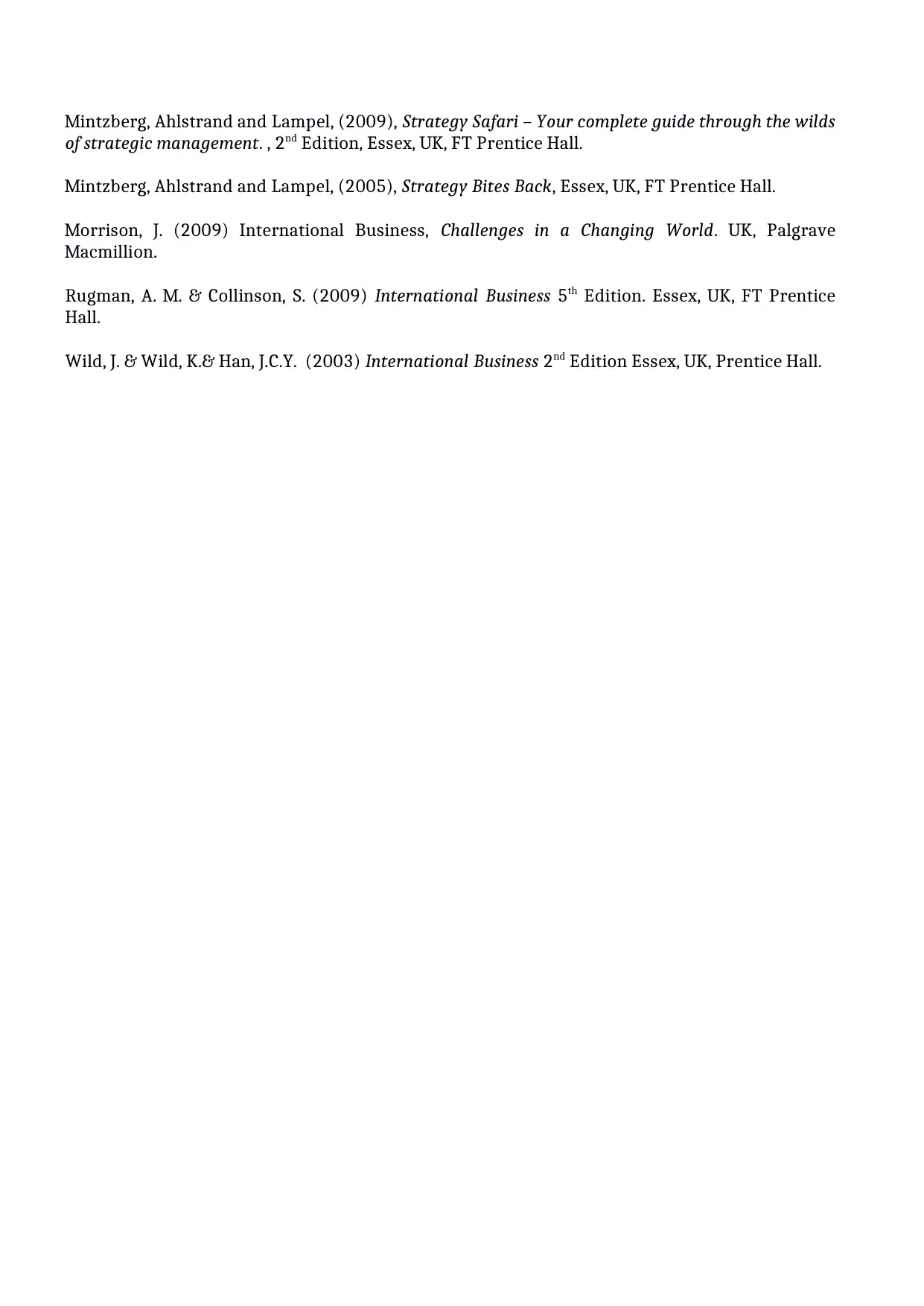
Mintzberg, Ahlstrand and Lampel, (2009), Strategy Safari – Your complete guide through the wilds
of strategic management. , 2nd Edition, Essex, UK, FT Prentice Hall.
Mintzberg, Ahlstrand and Lampel, (2005), Strategy Bites Back, Essex, UK, FT Prentice Hall.
Morrison, J. (2009) International Business, Challenges in a Changing World. UK, Palgrave
Macmillion.
Rugman, A. M. & Collinson, S. (2009) International Business 5th Edition. Essex, UK, FT Prentice
Hall.
Wild, J. & Wild, K.& Han, J.C.Y. (2003) International Business 2nd Edition Essex, UK, Prentice Hall.
of strategic management. , 2nd Edition, Essex, UK, FT Prentice Hall.
Mintzberg, Ahlstrand and Lampel, (2005), Strategy Bites Back, Essex, UK, FT Prentice Hall.
Morrison, J. (2009) International Business, Challenges in a Changing World. UK, Palgrave
Macmillion.
Rugman, A. M. & Collinson, S. (2009) International Business 5th Edition. Essex, UK, FT Prentice
Hall.
Wild, J. & Wild, K.& Han, J.C.Y. (2003) International Business 2nd Edition Essex, UK, Prentice Hall.
1 out of 16
Related Documents
Your All-in-One AI-Powered Toolkit for Academic Success.
+13062052269
info@desklib.com
Available 24*7 on WhatsApp / Email
![[object Object]](/_next/static/media/star-bottom.7253800d.svg)
Unlock your academic potential
© 2024 | Zucol Services PVT LTD | All rights reserved.





